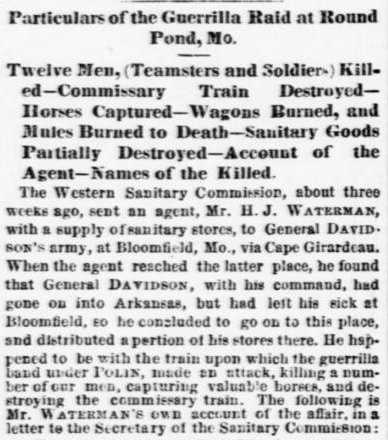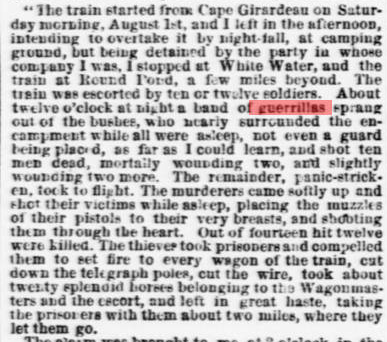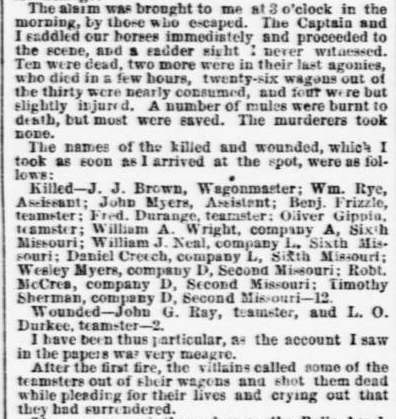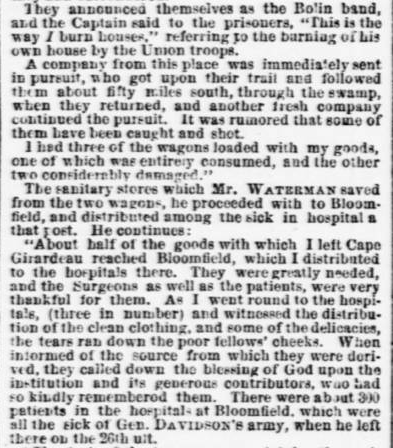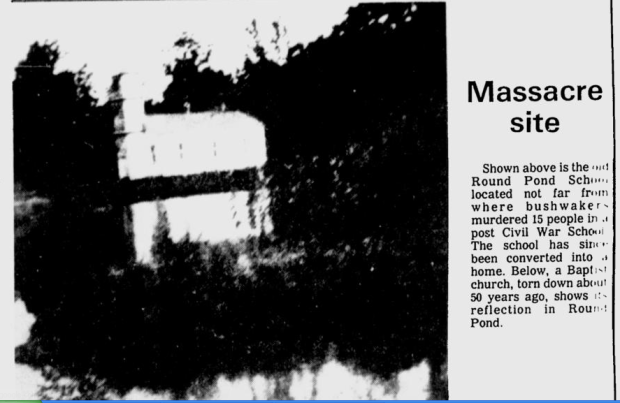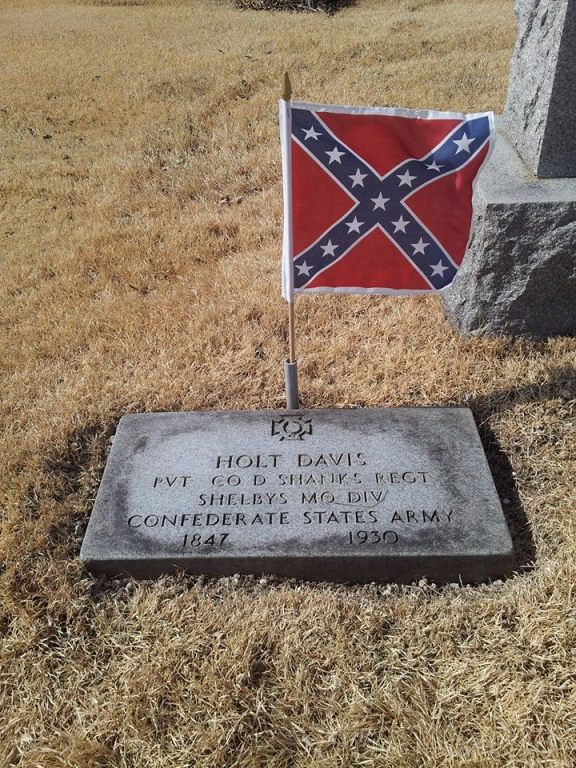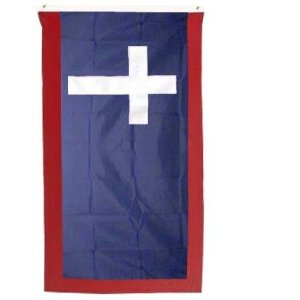Detailed Account of Battle of Round Pond proves it was “pay back”
The August 14, 1863 edition of the Daily Missouri Republican contains a detailed account of the Battle of Round Pond and while Union authorities claim it was murder in cold blood, it was not without provocation.
Guerrilla leader John Bolin proclaimed “That’s how I burn down houses” before shooting down one of the captured federal soldiers the paper proclaims that Bolin was “referring to the burning of his own house by Union troops” – Editor
Editors Note:
Round Pond was filled in many years ago and no longer exists but I did find a picture of it in the February 16, 1982 issue of the Southeast Missourian Newspaper.
Protecting the Past: J.M. “Hoss” Herman
J.M. Herman from Grain Valley, Missouri is a Sons of Confederate veterans member and founder of the Missouri Flaggers ( a grass-roots organization that takes a pro-active approach in defending Southern heritage. Herman has been busy as of late , re-setting and restoring the honor to many of Missouri’s Confederate Veterans like the gravestone of Private Holt Davis, of Shanks Regiment, General J.O. Shelby’s Division of Missouri Confederate Cavalry.
Remember Vicksburg…
12th Annual Coffee Camp Tour & Heritage Dinner
Don’t miss the 12 Annual Coffee Camp Historical Tour and Heritage Dinner April 21, 2012 in Osceola , Missouri. This year’s keynote speaker will be Donnie Kennedy co-author of the best selling book ” The South was Right”.
Click on the link for details!
Mo. Sons of Confederate Veterans Calls for Hate Crimes Prosecution
Press Release: 10/16/2011
Missouri Division, Sons of Confederate Veterans Calls for Hate-Crimes prosecution for Perpetrators of Monument Vandalism
Contact: Commander Jim England- cjengland@mindspring.com
Contact: Clint E. Lacy – mobushwhacker@att.net 573.208.5916
The Tuesday, October 11, 2011 Southeast Missourian newspaper found at the following URL,
http://www.semissourian.com/story/177254 carried a story about a Cape Girardeau, Mo. Confederate monument being vandalized.
This seemingly isolated incident is one of many that are occurring throughout the South. Monuments honoring veterans who fought for the Confederate States of America have been maligned by politicians on both sides of the aisle as well as media outlets.
Political Correctness has run amok. It has infiltrated our schools and our communities, resulting in the “dumbing down” of our students, our citizens, our family, friends and neighbors and the end result is ignorance, the latest display of which happens to be the vandalizing of a monument to soldiers from Cape Girardeau County and Southeast Missouri who gave their lives for their homes, their families, their ideals and their country.
The 1964 Federal Civil Rights Law, 18 U.S.C.§ 245(b)(2), permits federal prosecution of anyone who “willingly injures, intimidates or interferes with another person, or attempts to do so, by force because of the other person’s race, color, religion or national origin”
The Missouri Sons of Confederate Veterans strongly condemns the vandalizing of veterans monuments and calls for the swift prosecution of those who perpetrate these types of acts as hate crimes.
Cape Girardeau Confederate Monument Vandalised
From the Southeast Missourian newspaper 10/12/11
http://www.semissourian.com/story/1772540.html?response=no

Photo from the Southeast Missourian newspaper
“A Civil War monument on the grounds of the Common Pleas Courthouse in Cape Girardeau was struck by vandals who spray-painted both sides of the shrine with apparent pro-Union sentiments, nearly 150 years after the last shot was fired.
A two-man crew scrubbed black paint off the monument Tuesday morning. The men, from Marble Hill, Mo.-based Liley Monuments, said they hoped it would be graffiti-free by Tuesday afternoon.
But the message could still be read early Tuesday afternoon. “Go south” was written on the front of the shrine that sits along Lorimier Street near the fountain. That apparently was a request that the marker be moved, not a pro-South message. “We are in the union,” read the words on the back. “Obscene. Remove to [illegible] cemetary (sic) in the south.”
The workers from Liley said Tuesday afternoon they had tried industrial solvent and paint thinner, and the words were faded but still visible. One of the workers said getting the paint completely off Tuesday didn’t “look favorable,” but they would continue working through the afternoon.
By 3 p.m., a blue tarp had been wrapped around the monument and the workers were gone.”
City of Osceola, Missouri Condemns “Jayhawk” Mascott
Recently the City of Osceola, Missouri passed a resolution condemning KU’s “Jayhawk” mascot. The resolution reads as follows:
RESOLUTION
On this date, the City of Osceola, after hearing all of the evidence, and for good cause shown, finds the following:
1.
That on September 21 – 23, 1861, a group of domestic terrorist, referred to as “the jayhawkers,” sacked the city of Osceola, St. Clair County, Missouri and burned all but four or five of the city’s buildings to the ground.
2.
That on or around that date, twelve citizens of Osceola, St. Clair County, Missouri, were executed by said terrorist group.
3.
That the above-mentioned occurrence eventually led to William Clark Quantrill’s raid on Lawrence, kansas, as Missourians had no choice but to defend themselves from the murderous attacks perpetrated by the jayhawkers, led by Jim Lane and James Montgomery.
4.
That when the University of kansas fielded its football team in 1890, it referred to the team as “the jayhawkers,” an obvious celebration of the above-named terrorist group. This term was eventually shortened to “jayhawks,” a name which has since been officially adopted by the University of kansas as the mascot for all its sports teams.
5.
That the present-day “jayhawks,” kU alumni, citizens of the state of kansas, et al,, have willfully, wantonly and recklessly disregarded the above-mentioned occurrence when discussing the roots of the “Border War” which currently existed between the University of Missouri Tigers and the University of kansas jayhawks.
6.
Whereas, the Civil War Trust, Summer 2011 issue of “Hallowed Ground” published by the National Park Services does hereby acknowledge that partisan forces led by Jim Lane raided and sacked the town of Osceola, Missouri, executing nine men after a hastily arranged court martial.
IT IS THEREFORE RESOLVED that the City of Osceola, Missouri, by and through its citizens, officially CONDEMNS the celebration of this murderous gang of terrorists by an institution of “higher education,” in such a brazen and malicious manner.
IT IS FURTHER RESOLVED that citizens of the City of Osceola, Missouri requests the University of Missouri to educate the above-named Defendants on the FULL historical origins of the “Border War.”
IT IS FURTHER RESOLVED that no citizen of the City of Osceola or the alumni of the University of Missouri shall ever capitalize the “k” in “kansas” or “kU,” as neither is a proper name or a proper place.
_______________________
Larry Hutsler, Mayor
Attest:
_________________
City Clerk
(seal)
ESPN network’s Eamonn Brennan covered the story in his September 16th article entitled “The Dark side of the Jayhawk’s nickname“. Unfortunately the title is about the only thing accurate in this story. For instance, according to Brennan the good folks of kansas (yes I say good sarcastically) state that “Jayhawk” really isn’t really bad after all…
“Kansas doesn’t necessarily dispute this portion of the mascot’s history, but it asserts the term originated in a variety of ways, not all of them negative. On its “History of the Jayhawk” page, the KU athletics program says the term was originally coined in the late 1840s to describe a “band of pioneers” crossing over from Nebraska. Kansas athletics admits the term was used in the abolitionist conflicts Osceola describes, but notes that it became a patriotic symbol when then-Kansas Governor Charles Robinson raised a regiment called the “Independent Mounted Kansas Jayhawks.” “Rock Chalk Jayhawk” appeared soon thereafter, and in 1890 the name was passed along to Kansas’s first football team”
See , there you go, they were nothing more than a patriotic band of friendly volunteers (according to KU and Brennan). Brennan goes on to state:
“Yes, I just spent an entire paragraph summing up the disputed history of the term “Jayhawk.” Why? Because I’m a former history minor who loves these kinds of things. I sure didn’t spend that time typing because we needed a serious summation of both sides’ arguments. I mean, come on. With all due respect to the town of Osceola and what that town’s ancestors went through during the most violent and tumultuous time in America’s history, this happens to be 2011. There’s absolutely nothing offensive about the name “Jayhawk” in 2011. In fact, given the final words of the resolution — which you can view here — I’m not sure Osceola is even taking this all that seriously”
Oh come on Mr. Brennan! Yeah it’s 2011 and the town will never be what it could have been, because of KANSAS JAYHAWKERS! It does matter, the people of Osceola, have a reason to be offended. In 1861 Jim Lane , looted Osceola , not for slavery, not for the Union but for opportunity and financial gain. The University of Kansas has , as its symbol a “Jayhawk”, which does not symbolize a band of friendly pioneers, which isn’t a friendly little blue bird. It’s a symbol of murder and destruction in 2011. Why? For the same reason that the name Jayhawk represented in 1861..financial gain and profit.
I can’t help but wonder if the Jayhawk mascot represented violence against a minority group, oh I don’t know, like maybe African-Americans it would have been plucked long ago. Oh wait, Lane did terrorize African Americans too, a minor of history should know that Mr. Brennan.
Father “Abram” Ryan: Missouri Native, Priest / Poet of the Confederacy
The following article was written by an anonymous blogger known only to the world as “Enemy of the State” and submitted to the Southeast Missourian “Speak Out” forum found at the following URL: http://www.semissourian.com/forums/speakout/thread/3331
One Hundred, and Forty Six Years ago, on June 24th, 1865, the Poet Priest of the Confederacy, Father Abram Ryan, released his most famous poem, “The Conquered Banner.
It appeared in a pro-southern Catholic newspaper, the NEW YORK FREEMAN’s JOURNAL, since then, millions of southern children learned it by heart and recited it in classrooms throughout the south.
My guess is that no Cape Girardeau Catholics ever heard of Father Ryan, who was a free lane Chaplin to our soldiers in the Confederate Service, but they should have.
Nashville named a high school after Father Ryan.
The Sons of Confederate Veterans, Camp #302 in San Diego, CA, named their camp after Father Ryan.
A memorial plaque has been erected at his former parish, Immaculate Conception Church, in Knoxville, Tennessee.
A memorial park with a statue of Father Ryan is in downtown Mobile, AL.
Father Ryan is commemorated on the Poet’s Monument in Augusta, Georgia, along with Sidney Lanier, Paul Hamilton Hayne, and James Ryder Randall
There is a stained glass window at the Confederate Museum in New Orleans
There is a stained glass window depicting Father Ryan at Bapst Library, Boston College
A memorial plaque graces the front of St Boniface Church in Louisville KY, the remaining active portion of the Franciscan Monastery where he died. The adjoining monastery building is now apartments.
Why then, should Cape Girardeau Catholics honor this great man, a devoted priest, who risked his life to tend to the needs of loyal Confederate soldiers? It is because Father Ryan has a Cape Girardeau history.
Born born on February 5, 1839 in Hagerstown, Maryland, his parents soon moved to St. Louis, Missouri, where he was educated at the Academy of Christian Brothers. Later, Later Ryan studied for the priesthood at St. Mary’s of the Barrens Seminary near Perryville. He was ordained a Priest in the Vincentian order on September 12th, 1860. As a new priest, he taught theology at St. Mary’s of the Barrens and was also listed in 1860-61 on the faculty roster of the diocesan seminary in Cape Girardeau, Missouri.
It was from this area, that Father Ryan answered the call of the Archbishop of New Orleans who was recruiting Catholic Priests to be free lance Chaplins for the Confederate Service. Father Ryan began to be absent from duties due to “illness” so that he could travel to minister to troops in Tennessee, and Kentucky, Louisiana.
According to wikipedia, “Fr. Ryan began formal full-time clerical duties in Tennessee in late 1863 or early 1864. Though he never formally joined the Confederate Army, he clearly was serving as a free-lance chaplain by the last two years of the conflict, with possible appearances at the Battle of Lookout Mountain and the Battle of Missionary Ridge near Chattanooga (both in late November 1863), and well-authenticated service at the Battle of Franklin (November 1864) and the subsequent Battle of Nashville (December 1864). Some of his most moving poems–“In Memoriam” and “In Memory of My Brother”–came in response to his brother’s death, who died while serving in uniform for the Confederacy in April 1863, probably from injuries suffered during fighting near Mt. Sterling, Kentucky.”
All this makes Father Ryan a notable, highly regarded priest, to risk his life, even though he wasn’t in the Confederate Army, to minster to the troops.
However, that may not have been Father Ryan’s greatest accomplishment, though I would venture that to those who Father Ryan attended, they may disagree. Father Abram Ryan is best known as the Poet Priest of the Confederacy.
His poems, “CSA”, “In Memoriam”, and “The Conquered Banner” were, and still are, treasured in the south, and helped sooth it in it’s most difficult time, that being when they lost their war for Independence from the tyrannical northern government.
The latter, “The Conquered Banner” was required to be learned by all southern school students for many, many years, just as we were required to memorize the tyrants “Gettysburg Address.”
Father Ryan published volumes of poems, on the war, the military, and on other circumstances and several volumes of his work is even now available on eBay.
Imagine if you will, a Father Ryan Museum in Cape Girardeau. Cape would become a stopping point for not only bus loads of vacationing Catholics, but southerners who remember him fondly from learning about him in their high school years.
I am sure that there are records in Cape Girardeau that prove that Father Ryan was at the diocesan Seminary, (St. Vincents) and also at St. Mary’s in Perryville. Some enterprising Catholic ought to look into it as we celebrate the 150th Anniversary of our nations launch of it’s struggle for freedom from the vicious tyranny of the north.
At the very least, the Knights of Columbus ought to commemorate a plaque to this great man, this extraordinary Priest, Father Abram Ryan.
New Officers Elected for the Col. John T. Coffee Camp # 1934
The following are your new officers for the Colonel John T. Coffee Camp #1934:
Commander:
Jared Lawler
660-477-3449
1’st Lt. Commander:
Harold Simmons
417-637-2068
2cd Lt. Commander
George Eberhardt
Adjutant:
Willie Lawler
Past Commander/genealogist/ Newsletter Editor:
Gary Ayres
Press Officer/Webmaster:
Clint E. Lacy
573-208-5916
Chaplain:
Tim Mitchell
Chaplain:
Bob Phillips
Chaplain:
Larry Wheeler
Aid-de-Camp:
Garry Keene
Aid-de-Camp:
Mark Locke
Aid-de-Camp:
David Reif
Quarter Master:
B.J. Montgomery
Surgeon:
Dr. Dennis Hood, DVM
Congratulations to All! I bet we are the only camp in Missouri, perhaps nationally that has 3 Chaplains, 3 Aid-de-Camps, 3 Commanders, a Quartermaster and a Surgeon. The Coffee Camp, is starting to look more like an army!- webmaster
In North, Civil War sites ‘forgotten’
http://www.semissourian.com/story/1719652.html

“FRAMINGHAM, Mass. — The gravesite of a Union Army major general sits largely forgotten in a small cemetery along the Massachusetts Turnpike.
A piece of the coat worn by President Abraham Lincoln when he was assassinated rests quietly in a library attic in a Boston suburb. It’s shown upon request, a rare occurrence.
A monument honoring one of the first official Civil War black units stands in a busy intersection in front of the Massachusetts Statehouse, barely gaining notice from the hustle of tourists and workers who pass by each day.
As the nation marks the 150th anniversary of the Civil War, states in the old South — the side that lost — are hosting elaborate re-enactments, intricate memorials, even formal galas highlighting the war’s persistent legacy in the region. But for many states in the North — the side that won — only scant, smaller events are planned in an area of the nation that helped sparked the conflict but now, historians say, struggles to acknowledge it.
“It’s almost like it never happened,” said Annie Murphy, executive director of the Framingham History Center in Framingham, Mass. “But all you have to do is look around and see evidence that it did. It’s just that people aren’t looking here”
There are many interesting observations in this article. While the South is ridiculed as a whole with such stereo-types as being, poor, backward, stupid, etc. The North is portrayed as being progressive, morally superior and intelligent.
The South is not “stupid” or “backward” but it has something the federal government could never take away during its invasion, occupation and reconstruction of the Southern states and that is its fondness for tradition, heritage and culture. As the article states there are many reasons for the North’s complacency in regards to its heritage:
”
To be sure, some Northern states have Civil War events planned and have formed commemoration commissions. Connecticut’s 150th Civil War Commemoration was set up in 2008 and has scheduled a number of events and exhibits until 2015. Vermont, the first state to outlaw slavery, started a similar commission last year to coordinate activities statewide and in towns.
And some Massachusetts small not-for-profit and historic groups are trying to spark interest through research, planned tours and town events.
But observers say those events pale in comparison to those in the South.
That difference highlights Northern states’ long struggle with how to remember a war that was largely fought on Southern soil, said Steven Mintz, a Columbia University history professor and author of “Moralists and Modernizers: America’s Pre-Civil War Reformers.” For Northern states like Massachusetts, Mintz said revisiting the Civil War also means revisiting their own unsolved, uncomfortable issues like racial inequality after slavery. ”
To acknowledge the North’s issues with “racial inequality” before, during and after the Civil War, would be to knock down the pillars of the facade that the North went to war for racial equality. Acknowledgement of the North’s issues with “racial inequality” would lead to the acknowledgement that the Federal Government invaded the South to protect its flow of tax revenue from the South via import tariffs.
Most wars are fought for money, political power , protectionism and control of natural resources, this war was no different-webmaster
